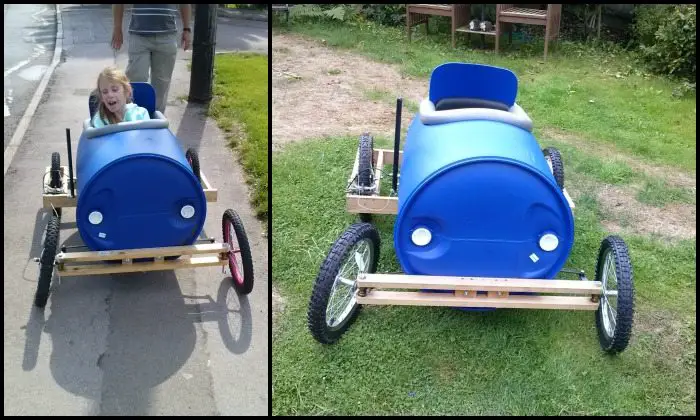
Playing with toy cars builds a child’s fine motor skills. They develop hand-eye coordination and dexterity in both hands. Sometimes, they even learn more by competing and working as a team.
Do you have kids who love cars, who want to enter a soapbox derby competition, or just love being active outdoors? Make them happy by making a soap box derby cart with plastic drum barrels!
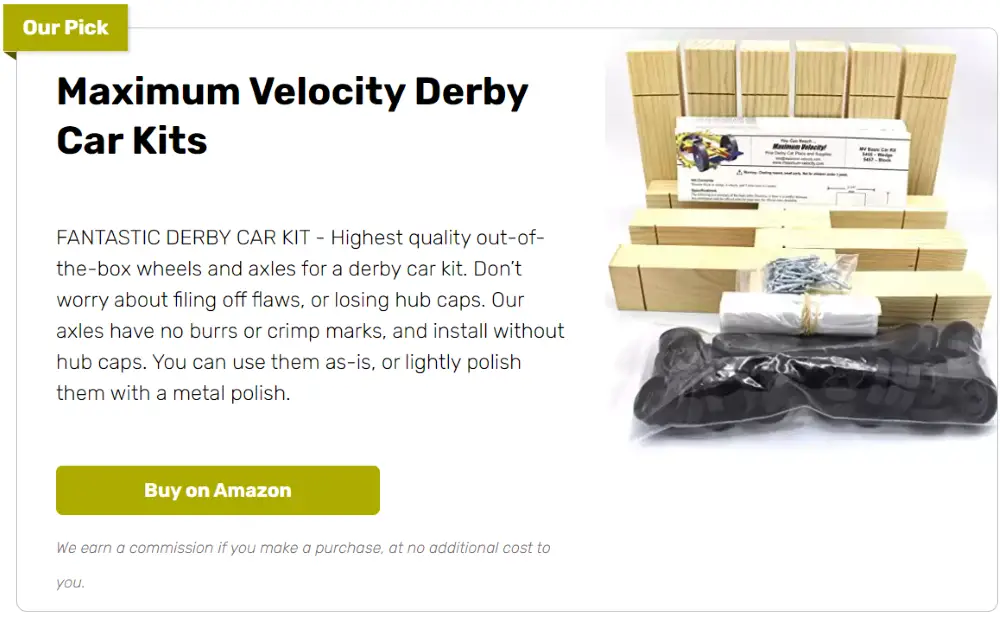
You can never go wrong with this DIY soap box derby cart project, especially if you customize it even more with a design that they will love!
What’s great about this soapbox derby is that you can create one entirely out of used parts and materials. You can even add accessories like headlights from junk shops or old cars. Just make sure that all your hardware is new and in good condition!

Read on to learn how to make this plastic barrel soapbox derby :)
Contents
Building a Soap Box Derby Cart
Materials
- 220 Litre Plastic Drum Barrel
- 4 Bicycle Weels (14″ – 20″ are ideal)
- 3 pieces, 1 meter long Timber
- 4 pieces Timber (75 mm longer than wheel diameter)
- M10 Bolts with matching Lock Nuts
- M8 Threaded Bar
- Screws
- Small Bolts
- 15 mm x 3 mm Steel Bar (for track rods and control arms)
- 2 – 15 mm equal T Plumbing Fittings
Tools
- Jigsaw
- Cordless Drill
- Measuring Tape
Instructions


Take your drum, and drill a hole on the side near the bottom big enough to take a jigsaw or padsaw blade. This is so the hole for the driver can be cut.
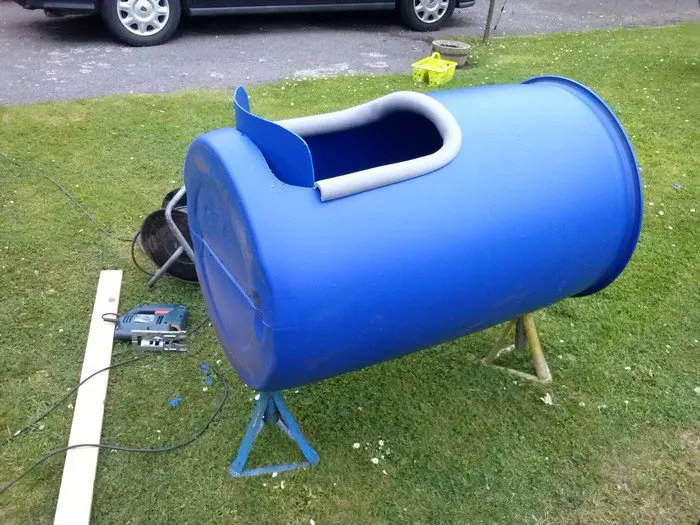

It needs to be big enough to allow easy ingress and egress but small enough to keep the cub safe when they eventually crash it.
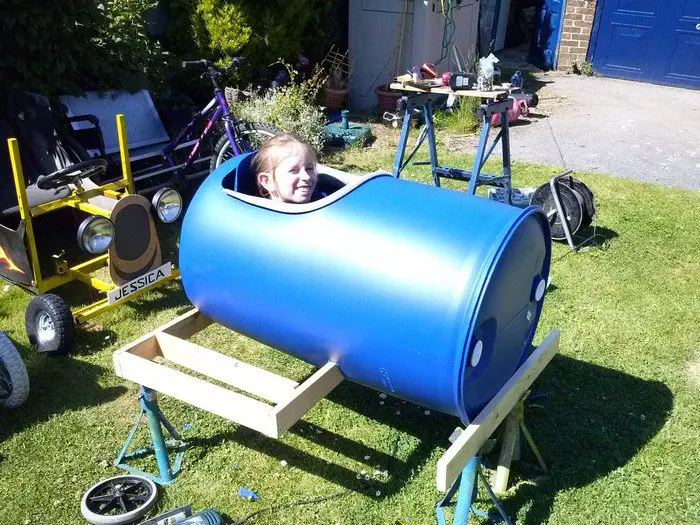

Rear wheels: For this stage, you need two of the 1 meter long pieces of timber. Bike wheels are great for soapboxes provided:
- they are not too large (less than 20″ is ideal)
- they often need to be supported on both sides
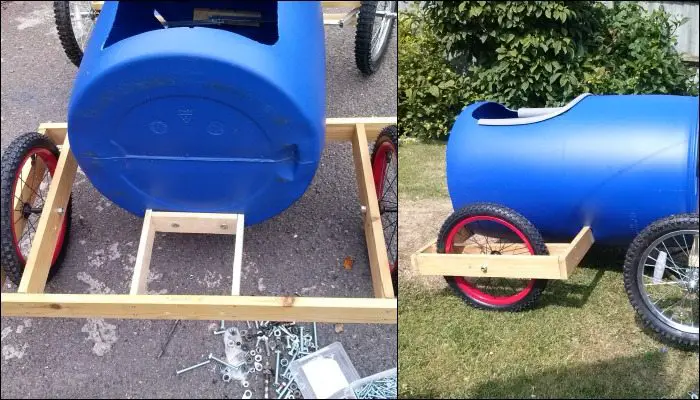

The two 1metre lengths feed across the width of the drum. These photos were taken when we were experimenting with the layout so the final version was slightly different…



but you do have to use what is now the rear of the cart to support the axle.
We also used our standard-issue 9 yr old to check the cockpit size.
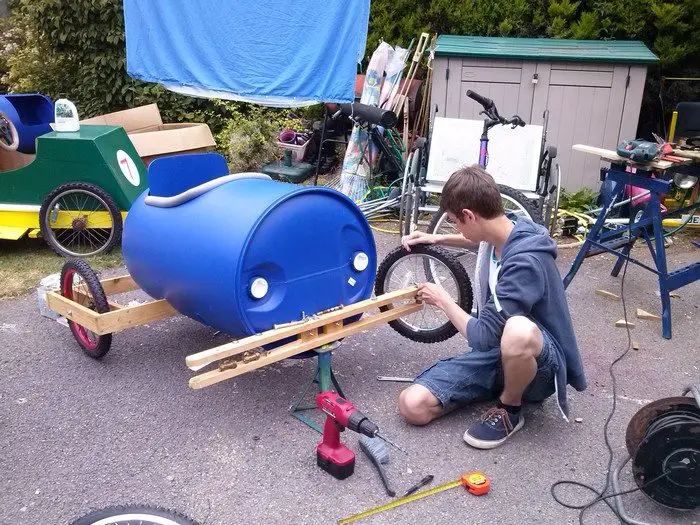

The front axle: Two pieces of 1metre timber mounted to the front of the drum. The gap between them is equal to the height of the 15mm equal T pipe fitting. You need to mount this securely and centrally at the front, more stress is imparted as the loads feed into the drum and axle in a smaller area than at the rear.


The 15mm T is drilled to match the bike wheel axle, we were able to adjust the wheel axle so we could offset the wheel and allow more thread to be supported through the T piece.


The control arms mount onto the wheel axle, it’s made from the steel bar. The bar is heated so it can be bent and twisted.
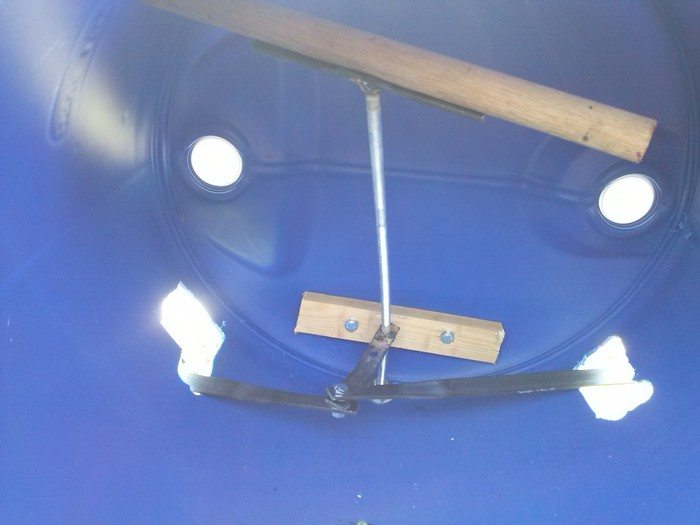

Steering: It’s a simple Pitman Arm arrangement. The M8 threaded bar is used as the steering column. A hole is drilled at the bottom front of the drum and the bar is threaded through. It is held in place with nuts and washers.
The Pitman arm is made from the steel bar and is positioned using nuts, once in the right place these are welded to lock the arm in place. The steering wheel is made from a more steel bar with a nut welded to it and again once in the right place welded into place (although you could use lock nuts).
An old broom handle is screwed to the steering wheel bar to make it more comfortable to use. A steel bar is used to create the track rods.
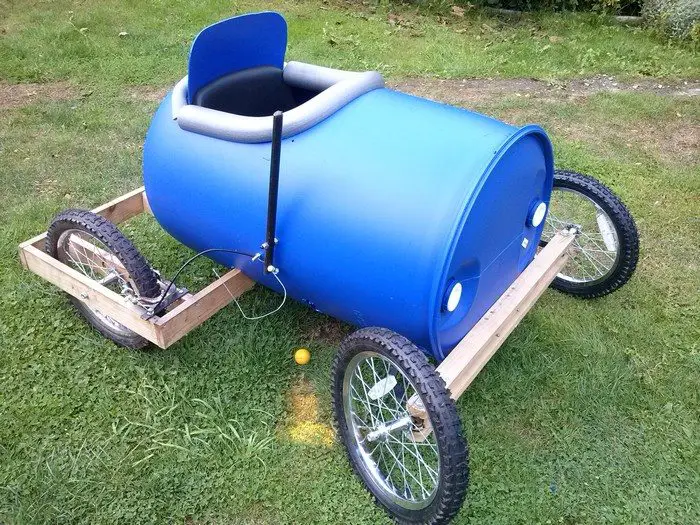

An old plastic chair was sacrificed and screwed into the cart so that the driver is a little more comfortable.
The brake is simply taken from an old bike and mounted on the rear axle frame and operated via a simple lever.


We hope this project helps in your plan to build a ‘car’ for your kids. Now go ahead and let your creative juices flow — customize and improve your plastic barrel car with your unique and wonderful designs! :)
Thanks to GarethMorris for this great project!
Safety Measures for Building and Racing a Soap Box Derby Cart
Building and racing a soap box derby cart can be an exhilarating activity for children and families. However, ensuring the safety of everyone involved is paramount. By adhering to these safety measures, you can minimize risks and ensure that the soap box derby cart provides a secure and enjoyable experience.
Design and Construction Safety
- Choose Strong, Reliable Materials: Ensure that all materials used in the soap box derby cart, such as the frame, wheels, and axles, are sturdy and capable of withstanding the stresses of racing. Avoid materials with cracks, sharp edges, or signs of deterioration.
- Secure Attachments: Double-check that all parts of the soap box derby cart are securely attached. Use lock nuts and bolts, and make sure all joints are reinforced. This prevents parts from loosening during a race.
- Weight and Balance: Properly balance the soap box derby cart to avoid tipping. Test the cart’s stability by placing weight in the driver’s seat and observing whether it remains stable in various conditions.
Protective Gear
- Helmets are Mandatory: Always ensure that the driver wears a properly fitted helmet. The helmet should meet safety standards appropriate for high-impact sports.
- Padding and Safety Harnesses: Equip the soap box derby cart with padding around the cockpit area to protect the driver from injury during bumps or crashes. Consider using a safety harness if the race course has significant slopes or turns.
Braking and Steering System Check
- Reliable Braking System: Install an effective and easily accessible braking system. Test the brakes before each race to ensure they are responsive and capable of bringing the soap box derby cart to a complete stop.
- Efficient Steering: The steering system should be easy for the driver to control. Regularly check that the steering is smooth and does not stick, ensuring the driver can navigate turns safely.
Pre-Race Inspections
- Routine Checks: Before any racing event, conduct a thorough inspection of the soap box derby cart. Look for any signs of wear and tear, especially on crucial components like the wheels and axles.
- Test Runs: Perform several test runs to ensure the soap box derby cart operates smoothly. This also helps the driver get accustomed to the cart’s handling, improving their confidence and safety on race day.
On-Site Safety Measures
- Racecourse Inspection: Familiarize yourself with the racecourse prior to the event. Ensure it’s free of obstacles and properly secured, with adequate space for stopping at the end of the race.
- Supervised Racing: Always have adults supervise the racing activities. This ensures that help is readily available in case of an emergency.
By implementing these safety measures, participants in soap box derby cart events can focus on the fun and competitive aspects of racing, secure in the knowledge that they have taken the necessary steps to protect all involved.
Soap Box Derby Racing Strategies
Participating in a soap box derby race involves more than just building a fast cart; it requires strategic thinking and preparation to maximize your performance on race day. Here are some essential racing strategies to consider when entering your soap box derby cart in a competition.
These tips can help drivers gain an edge over the competition and potentially lead to a successful and enjoyable racing experience.
Understanding the Track
- Study the Course Layout: Before the race, take the time to study the track layout. Knowing where the turns, dips, and straightaways are can help you plan where to accelerate and where to be cautious.
- Inspect the Track Surface: Examine the racing surface for any irregularities or debris that could affect the soap box derby cart’s stability and speed. Planning for these elements can prevent accidents and improve performance.
Optimizing the Start
- Mastering the Launch: A good start can make a significant difference. Practice launching the soap box derby cart to get off to a quick and smooth start. This often involves knowing how to position your body for maximum push-off and initial acceleration.
- Positioning: If you have a choice, position your cart in a spot on the track that has shown to be fastest during trials or previous races. Sometimes the inner or outer lanes may have advantages based on the track condition and design.
Driving Techniques
- Maintaining Optimal Speed: Learn how to maintain momentum, especially through curves and downhill segments. Avoid unnecessary braking or sharp turns that could slow down the soap box derby cart.
- Balancing Weight: Train the driver on how to shift their weight during turns to help maintain balance and prevent the cart from tipping. Strategic weight shifting can also help in increasing speed on straight sections.
Aerodynamics
- Streamline the Cart: Ensure that your soap box derby cart is as aerodynamic as possible. This means having a design that minimizes air resistance. Smooth surfaces and a pointed front can help reduce drag.
- Tuck In: Teach the driver to stay low and tuck their head down during the race to reduce wind resistance, which can significantly impact speed on longer or windier tracks.
Regular Practice
- Rehearse on a Simulated Track: If possible, practice on a track similar to the one used in the competition. This will not only help the driver get used to the soap box derby cart’s responses but also fine-tune their racing strategy based on real conditions.
- Conditioning and Familiarity: Regular practice increases the driver’s comfort level with the cart’s dynamics and responsiveness, improving their reaction times and confidence during the actual race.
By focusing on these strategic aspects of soap box derby racing, participants can enhance their overall racing technique and improve their chances of success. Effective preparation combines both the mechanical readiness of the cart and the skillful handling by the driver, creating a thrilling and competitive racing experience.
Conclusion
Building a soap box derby cart offers a rewarding opportunity for creativity and teamwork, allowing both children and adults to engage in a hands-on project. Through careful planning, construction, and testing, participants can ensure their cart is both safe and competitive for racing. This activity not only fosters a sense of accomplishment but also strengthens community ties and provides endless fun during the races.
We have more incredible projects for your kids. Check out our water wall guide next!






